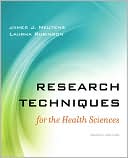

 |

|

Sold Out
Book Categories |
Preface xiii
Chapter 1 What Is Research? 1
Health Science Research 1
Using Science in the Quest for Knowledge 2
Summary 10
Critical Thinking Questions 11
Suggested Activities 12
References 13
Chapter 2 Developing the Research Proposal 14
Selection of the Problem 14
Sources of Problems 15
Statement of the Problem and Research Questions 17
Subproblems 18
Components Comprising the Setting of the Problem 19
Formulation of Hypotheses 20
Significance and Justification of the Problem 21
Resume of Related Literature 22
Proposed Research Procedures 23
Budget Considerations 23
Time Schedule 23
Research Proposal Checklist 24
Summary 26
Critical Thinking Questions 26
Suggested Activities 27
References 27
Chapter 3 Critical Review of the Literature and Information Sources 29
Purposes of the Review 29
Steps in the Review Process 31
Conducting a Computer Search: Finding the Evidence 35
Determining the Level of Evidence 37
Finding Shortcuts to Determining the Level of Evidence 45
Writing the Section on Related Literature 45
Summary 47
Critical Thinking Questions 47
Suggested Activities 48
References 48
Chapter 4 Considering Ethics in Research 50
Case Study 50
General Ethical Dilemmas in Human Research 51
Justification to Experiment on Humans 54
Vulnerable Target Groups: Children 55
Vulnerable Target Groups: Elderly 57
Informed Consent: Truthtelling and Deception 58
Right to Privacy and Confidentiality 60
Responsibility for Harmful Consequences 62
The Duty to Continue a Successful Research Effort 63
Therapeutic and Nontherapeutic Research 64
Sponsored Research 64
Publication of UnethicalResearch 65
Research or Just a Look-See? 65
Role of the Institutional Review Board 66
Case Discussion 70
Summary 70
Critical Thinking Questions 71
Suggested Activities 72
References 72
Chapter 5 Conducting Experimental and Quasi-Experimental Research 74
Case Study A 74
Case Study B 74
Characteristics of Experimentation 75
Control in Experiments 76
The Hawthorne Effect in Controlling Situations 77
Advantages and Disadvantages of the Experimental Method 78
Internal and External Validity 78
Constructing Experimental Designs to Control Variables 84
The Randomized Controlled Trial: Clinical Trials 88
Case Discussion for Case Study A 94
Case Discussion for Case Study B 95
Summary 95
Critical Thinking Questions 96
Suggested Activities 96
References 97
Chapter 6 Data Collection Through Surveys and Self-Reports 99
Case Study 99
Characteristics of Survey Research 99
Survey Flow Plan 100
Survey Design 103
Data Collection Methods 104
Survey Sampling 111
Questionnaire Design and Construction 112
Attitude Scale Construction 117
Cover Letter 122
Pretesting and Questionnaire Revision 122
Focus Groups 124
The Delphi Technique 124
Case Discussion 126
Summary 127
Critical Thinking Questions 128
Suggested Activities 128
References 129
Chapter 7 Sampling Designs and Techniques 133
Case Study 133
The Purpose of Sampling 134
The Sampling Frame 134
Sampling Techniques 135
Sample Size 141
Sample Size for Studies with Hypothesis: Analytical Studies 142
Sample Size for Studies Without Hypotheses: Surveys and Descriptive Studies 143
Case Discussion 149
Summary 150
Critical Thinking Questions 151
Suggested Activities 151
References 152
Chapter 8 Qualitative Research 153
Case Study 153
Characteristics of Qualitative Research 153
Theoretical Foundations 157
Methods of Qualitative Research 158
Techniques of Collecting Qualitative Data 170
Analyzing Qualitative Data 176
Using Computers in Data Analysis 178
Case Discussion 179
Summary 179
Critical Thinking Questions 180
Suggested Activities 180
References 181
Chapter 9 Evaluation Research 182
Case Study 182
Introduction 182
Purposes of Evaluation Research 183
What Can Be Evaluated? 184
Steps in Conducting Evaluation 184
Evaluation Models 188
Types of Evaluation Research 197
Methodological Approaches in Evaluation Research 204
Case Discussion 210
Summary 210
Critical Thinking Questions 211
Suggested Activities 212
References 212
Chapter 10 Analytical Epidemiologic Studies 214
Case Study A 214
Case Study B 214
The Nature of Epidemiology 215
Analytical Methodologies in Epidemiology 215
Cohort Investigations 217
Case-Control Studies 218
Establishing Causation 220
Problems of Error 220
Control in Epidemiological Research 222
Analysis of Results in Analytic Epidemiology 224
Case Discussion of Case Study A 232
Case Discussion of Case Study B 232
Summary 233
Critical Thinking Questions 234
Suggested Activities 234
References 235
Chapter 11 Analyzing and Interpreting Data: Descriptive Analysis 237
Case Study 237
The Meaning of Statistics 238
Statistical Analysis and Data 238
Descriptive Data Analysis Techniques 240
Personal Computers and Information Delivery Systems 250
Case Discussion 252
Summary 253
Critical Thinking Questions 253
Suggested Activities 253
References 255
Chapter 12 Analyzing and Interpreting Data: Inferential Analysis 256
Case Study A 256
Case Study B 257
Inferential Analysis 257
Estimation of Parameters 258
Hypotheses Testing 259
Inferential Data Analysis Techniques for Comparing Mean Scores 263
Measures of Relationship and Predictions 268
Nonparametric Tests of Significance 269
Meta-Analysis 271
Case Discussion of Case Study A 273
Case Discussion of Case Study B 273
Summary 273
Critical Thinking Questions 274
Suggested Activities 274
References 275
Chapter 13 Techniques for Data Presentation 276
Case Study 276
Table Presentations 276
Table Format 281
Figure Presentations 286
Graphics and the Computer 293
Case Discussion 293
Summary 293
Critical Thinking Questions 294
Suggested Activities 294
References 294
Chapter 14 Writing a Research Report 295
The Report as a Communication Document 295
Preliminaries 296
Text or Main Body of the Report 299
References 306
Appendixes 307
Writing Style 307
Summary 308
Critical Thinking Questions 309
Suggested Activities 309
References 309
Appendix A Common Statistical Procedures 311
Appendix B World Wide Web Research 314
Name Index 317
Subject Index 321
Login|Complaints|Blog|Games|Digital Media|Souls|Obituary|Contact Us|FAQ
CAN'T FIND WHAT YOU'RE LOOKING FOR? CLICK HERE!!! X
 You must be logged in to add to WishlistX
 This item is in your Wish ListX
 This item is in your CollectionResearch Techniques for the Health Sciences
X
 This Item is in Your InventoryResearch Techniques for the Health Sciences
X
 You must be logged in to review the productsX
 X
 X

Add Research Techniques for the Health Sciences, , Research Techniques for the Health Sciences to the inventory that you are selling on WonderClubX
 X

Add Research Techniques for the Health Sciences, , Research Techniques for the Health Sciences to your collection on WonderClub |